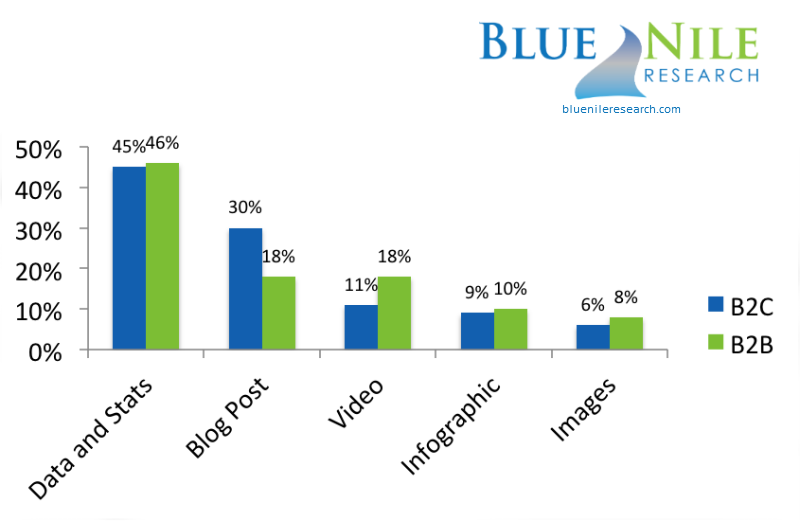Study: The Content That Compels People to Buy
Contributor Nathan Safran reveals key findings from a study by Blue Nile Research on which content types are most likely to appeal to consumers during the buyer journey.
The internet has deeply and thoroughly affected the way consumers research and buy. Ecommerce is rapidly growing and has been a great equalizer in allowing consumers to research a brand or product before each purchasing decision.
According to Forrester’s “US eCommerce Forecast: 2013 To 2018” report, consumers will be spending $414 billion online by 2018, a 57.4-percent increase from 2013.
The self-serve nature of the internet has created a huge opportunity for brands to invest in content and cross-channel distribution of their content. Because there have been massive increases in investment in digital content and its distribution, plenty of research has been published that measures the digital levers marketers pull when it comes to the digital content and distribution channels they invest in.
Far less has been done in measuring what actually works. What content really compels people to buy? What channels do consumers use to make a buying decision? How does that differ when making a B2C purchase versus B2B?
Sure, marketers have their own analytics to tell them what does and does not work on their own sites, but it is colored by their own starting assumptions and biases, giving them a skewed view of what globally resonates with buyers.
To better close the gap between published research on what marketers do and what actually works, Blue Nile Research designed a study to measure the content that buyers turn to in a buying and research process (disclaimer: I am Blue Nile’s founder and CEO).
We surveyed 528 US respondents via online survey, segmenting B2B versus B2C questions for insight into the behaviors of each buyer.
Both B2B & B2C Buyers Want Cold, Hard Facts
One of the ways we tested respondents for the content that resonates most in a buying process was to ask them to imagine they are in the market for a specific item (B2C: sneakers; B2B: Data Analytics software).
We then showed respondents different headline types that mapped to content types and asked which they were most likely to click on. This method allowed us to identify the content types that most resonate with buyers and to compare B2B and B2C preferences.
Several key insights emerged from the analysis:
- Buyers choose the data/statistics headline most, 45 percent of the time in the B2C scenario and 46 percent in B2B. In describing why he preferred data and statistics in the buying process, one respondent said:
“I like to be able to compare specifications on top of price to get the specs I want for the price I am willing to pay.”
- B2C buyers prefer blog posts at a far greater rate than B2B buyers. One respondent commented:
“Data is usually concatenated into personal experiences within blog posts, and I will use the recommendations as a starting point before looking up prices and specifications.”
- B2B buyers actually preferred video at a greater rate than B2C. One respondent observed:
“It’s to the point, and it is easier to watch video”.
We attribute this skew to the tech startup trend of “explainer videos” that have been effective at explaining a complex product. The data suggest that B2B sellers should seriously consider video as a medium to explain their value proposition, since nearly 20 percent of B2B buyers view it as compelling during the buying process.
- With barely 10 percent of respondents choosing infographics, it is clearly a top-of-the-funnel tool. Marketers like them because they have the potential to be viral, but they should not be thought of as a compeller during the buying process.
Perhaps most significantly, close analysis of headline click preferences shows that although 45 percent to 46 percent of buyers choose data and stats as the most compelling content type, they are not an overwhelming majority.
In reality, we see a fairly broad distribution of content types that resonate across the distinct types. This suggests a “different strokes for different folks” strategy that encompasses a breadth of content types to ensure broad appeal.
Here are two other questions we asked in the study, along with the type of headline that won out.
B2C: Imagine you are in the market for a new air conditioning unit. Upon searching Google for “Air Conditioning Unit,” the following results appear. Which headline would you be most likely to click on?
B2B: Imagine you are the buyer for your company for new data analytics software. The following headlines appear when you search Google for “Data Analytics Software.” Which are you most likely to click on?
This research shows buyers in an online research and buying process look primarily for hard facts to justify their purchase, but they also look for a broad range of content types to help make a purchase.
To give themselves the best chance of converting searchers to buyers, marketers must be prepared with all of the various kinds of content that appeal to buyers as they’re doing research in advance of a purchase.
Opinions expressed in this article are those of the guest author and not necessarily MarTech. Staff authors are listed here.
Related stories

